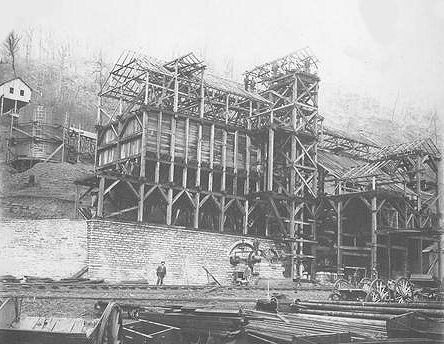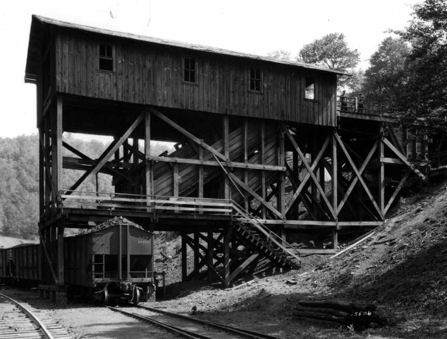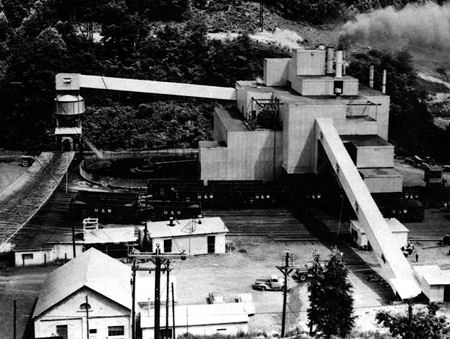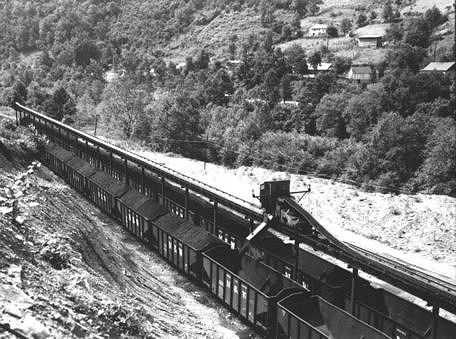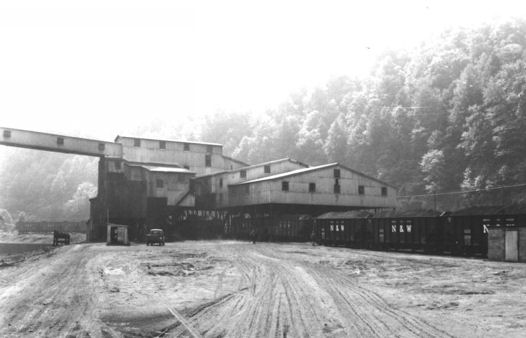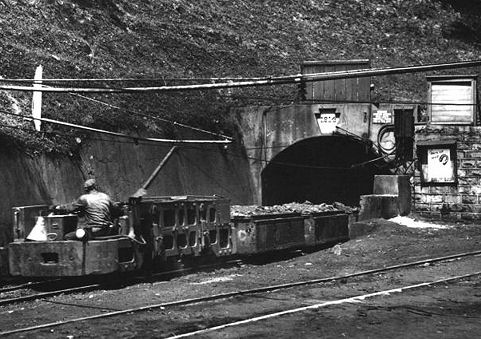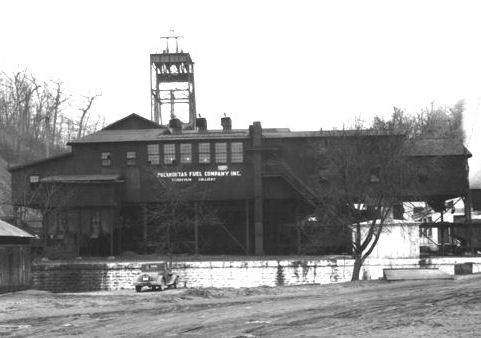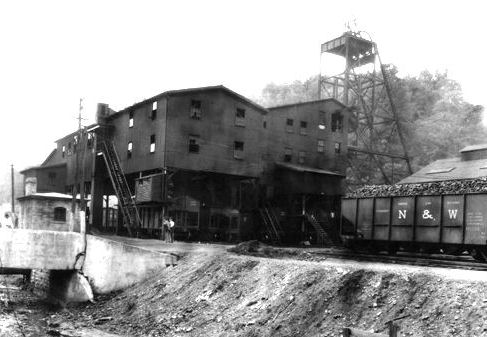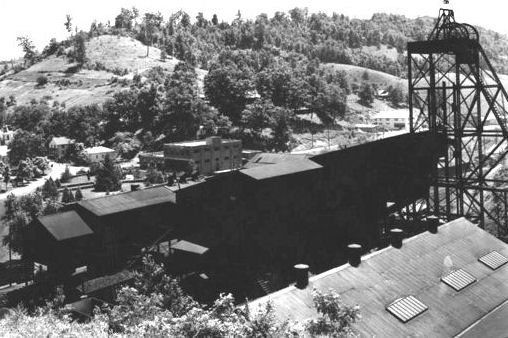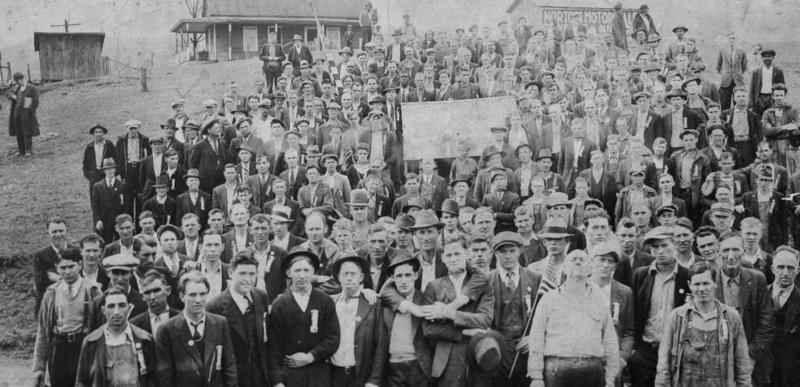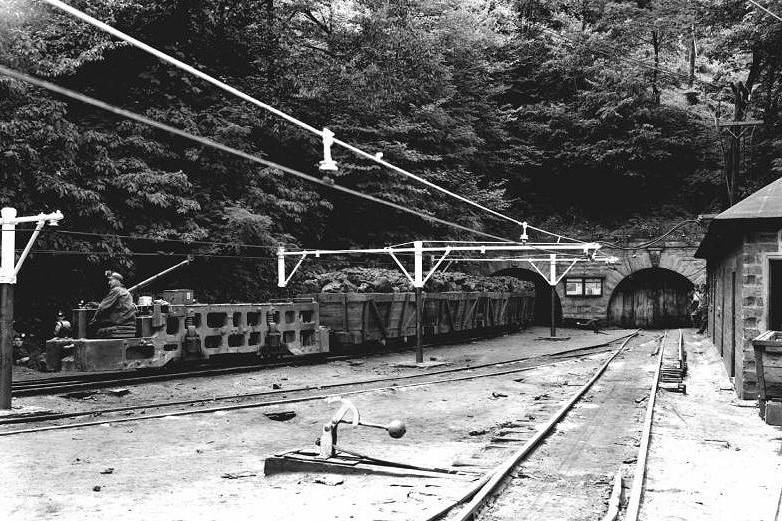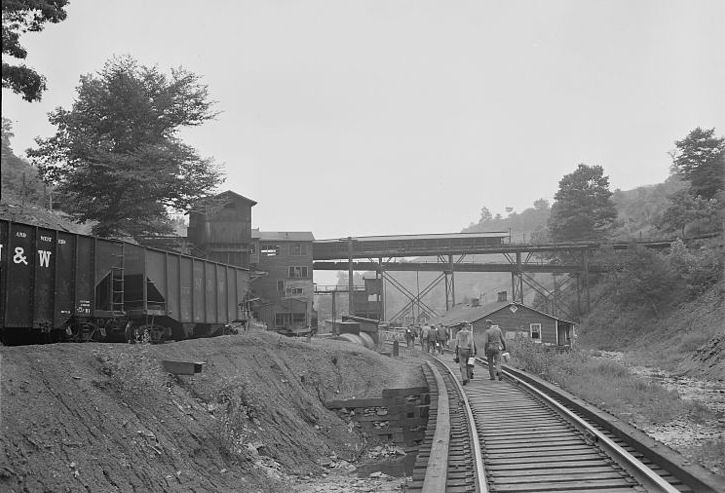VIRGINIA MINES
Tom's Creeks Coal & Coke Company, Coeburn, Wise Co., VA, 1895
The first settlers at Jamestown may have searched for gold, but the primary mineral wealth of Virginia was in the iron deposits until the Civil War.
Early mining in Virginia began with the mining of bog iron ore near Jamestown in 1609. The first ironworks were set up in 1619 approximately 66 miles above Jamestown on the James River. The Virginia ironworks were small local operations using local sources of ore for raw material. In the Piedmont and the Shenandoah Valley, bloomeries and then iron furnaces provided an industrial component to the agricultural economy. Even the Coastal Plain had iron furnaces . Before 1622, an iron works was started at Falling Creek upstream from Jamestown. Governor Spottswood developed an iron plantation (rather than one based on tobacco) at Germanna, and George Washington's father Augustine managed an iron works in Stafford County just north of Fredericksburg. In the 1730's, both the Neabsco Iron Works on Neabsco Creek (near Potomac Mills) and a furnace/foundry at Occoquan were developed in Prince William County. They used water power from the streams to pump furnace bellows, and the Potomac River to ship the heavy product.
However, with the development in the early 1800's of more-efficient iron furnaces in Pennsylvania using coal and coke rather than charcoal for fuel, Virginia's iron mining and processing industry declined. Place names such as Catherine Furnace and Clifton Forge dot the map of Virginia, but the primary value of iron deposits in Virginia now is for paint pigment.
The only other metal of any importance in colonial America was lead, which was used mostly for bullets. The Austinville Lead/Zinc Mine in Wythe County, Virginia operated in the 1700’s and was important in the Revolutionary War.
The materials mined in the 1900’s included the only arsenic mined east of the Mississippi River, the Brinton Mine, which operated from 1912-1917. Manganese and iron mining continued throughout the state until production ceased for the most part in the 1950’s. The Crimora Mine, the largest producer of manganese in the United States, operated until 1958. Titanium ore mining and processing continued from the 1940’s to the early 1970’s.
In Montgomery County, the Merrimac Mine on Price Mountain (between Christiansburg and Blacksburg) shipped coal to Norfolk via the Virginia and Tennessee railroad east to Lynchburg in the 1850's.
After the railroad arrived in the 1880's, the Appalachian Plateau, especially Buchanan, Dickenson, and Wise counties, shifted from subsidence agriculture to a cash economy based on lumbering and mineral extraction. Company towns were constructed and new employees recruited to man the deep mines. Mining communities grew up and shut down, based on the boom and bust cycles of the international energy markets. This population influx, and then the emigration when mines closed, altered the racial and social balance dramatically.
Pocahontas, in Tazewell County, was Virginia's first coalfield boom town, and is listed on the National Register of Historic Places. The original Pocahontas Exhibition coal mine opened in 1882, with 44,000,000 tons of coal mined before it closed in 1955. The Pocahontas Exhibition Mine is the site of the original Pocahontas 'Baby' Mine, which was the first coal mine opened in the Pocahontas Coal Fields. The Southwest Virginia Improvement Company built The Old Company Store in February of 1884. This was the first company store erected in the great Pocahontas Coal Fields. On the first level was the company store and on the upper levels were ample space for mining offices.
Pocahontas Coalfield, which is also known as the Flat Top-Pocahontas Coalfield, is located in Mercer County, West Virginia, McDowell County, West Virginia and Tazewell County, Virginia. The coal seams, Pocahontas No. 3, No. 4, No. 6, and No. 11 are some of the best coal to be found in the world. The earliest coal mine in the coalfield was in Pocahontas, Virginia in 1883 at Pocahontas Mine No. 1, now on the National Register of Historic Places. This operation, replete with beehive coke ovens, eventually spawned the Pocahontas Fuel Company, which operated mines in Virginia at Boissevain and Amonate, and in West Virginia at Jenkinjones, Bishop, and Itmann. Later Pocahontas Fuel Company was absorbed into Consolidation Coal Company, which still mines coal at Amonate.
By World War I, after the Norfolk and Western railroad built a rail line down the New River from Radford, then through West Virginia to the coal fields, the Pocahontas Mine became a major supplier of coal for the Navy. The Pocahontas Coalfield continued to thrive through two world wars. The United Mine Workers union gained a foothold in the coalfield after the 1930s.
In eastern Virginia, coal was mined in the 1700's from the Triassic Basin west of Richmond/Petersburg, near Midlothian in Chesterfield County. From Chesterfield County south of Richmond, coal was carried on rails in mule-pulled carts to Manchester and Richmond. Later, mules were replaced by locomotives fueled by wood. The small size of that Midlothian coal field limited its importance to the local market.
Clinchfield Coal Co. - Cranes Nest, VA - 1931
Pocahontas Fuel Co. Mine - Boissevain, VA
Keystone, WV - Koppers Coal Co.
Clinchfield Coal Co. - Duty, VA
Panther Coal Company - Grundy, VA
Island Creek Coal Co. - Keen Mountain, VA
Panther Red Ash Coal Corp., Mine No.1 - Oakwood, VA
Pocahontas Fuel Co. Mine - Boissevain, VA
Pocahontas Fuel Co. Mine - Boissevain, VA
Unidentified Miners - Pocahontas, WV - 1920's
UMWA Tom's Creek Local 6227, Norton, VA
Pocahontas Fuel Company - Pocahontas Virginia
Raven Red Ash Coal Tipple - Lower Red Ash, VA
UMWA Tom's Creek UMWA Local 6227, Norton, VA
